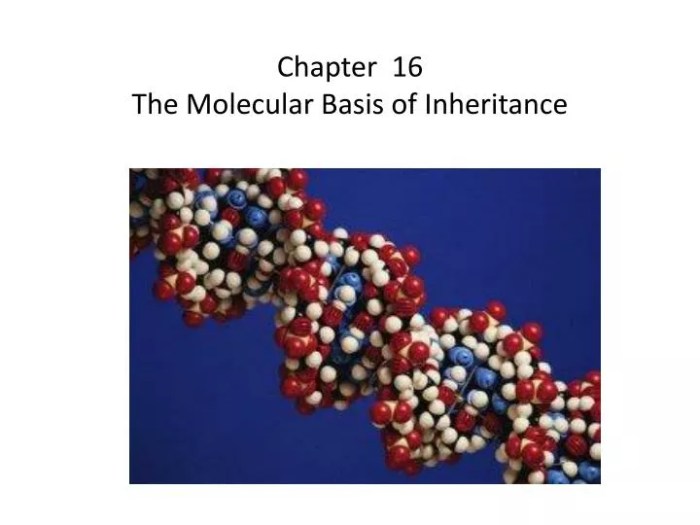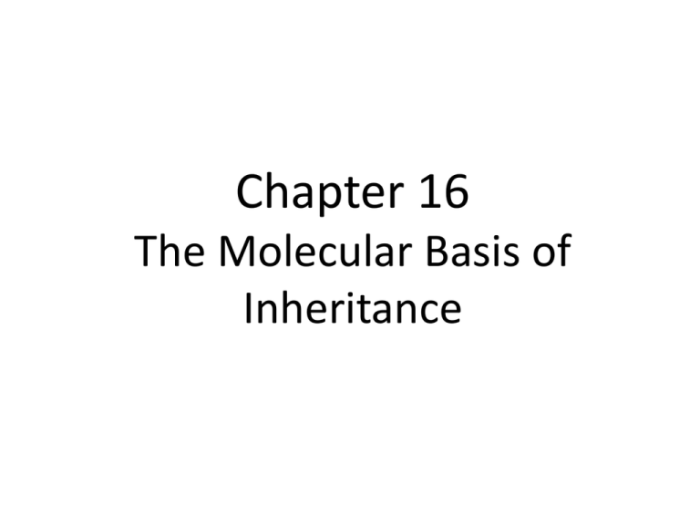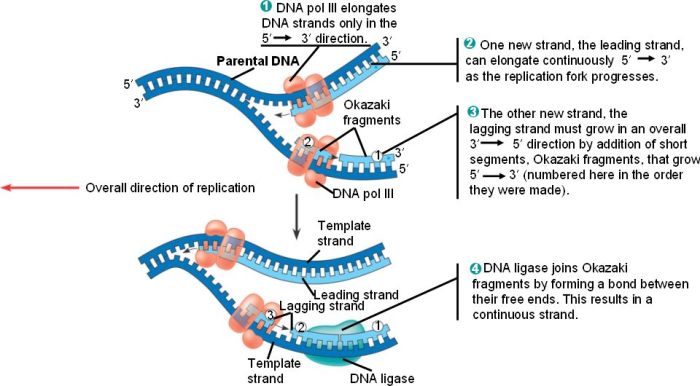Chapter 16 the molecular basis of inheritance – Chapter 16: The Molecular Basis of Inheritance embarks on an illuminating journey into the fundamental principles that govern the transmission of genetic information. This chapter unravels the intricate relationship between DNA, the blueprint of life, and its pivotal role in shaping the characteristics passed down from one generation to the next.
Delving into the molecular architecture of DNA, we uncover its double-helix structure and explore the mechanisms by which it stores and transmits genetic information. Through captivating examples, we witness how DNA orchestrates the inheritance of diverse traits, laying the foundation for the remarkable diversity observed in the living world.
1. Molecular Basis of Inheritance

The molecular basis of inheritance refers to the fundamental principles that govern how traits are passed down from one generation to the next. This process is made possible by the presence of deoxyribonucleic acid (DNA), a molecule that carries genetic information within cells.
Structure and Function of DNA
DNA is a double-stranded molecule composed of four different types of nucleotides: adenine (A), thymine (T), guanine (G), and cytosine (C). These nucleotides are arranged in a specific sequence along the DNA molecule, which determines the genetic code.
The double-stranded nature of DNA allows for the formation of base pairs between A and T, and G and C. These base pairs form the backbone of the DNA molecule and provide stability to the structure.
Role of DNA in Inheritance
DNA plays a crucial role in inheritance by transmitting genetic information from parents to offspring. During cell division, the DNA molecule is replicated, ensuring that each daughter cell receives an identical copy of the genetic material.
The sequence of nucleotides in DNA determines the amino acid sequence of proteins. Proteins are the building blocks of cells and are responsible for a wide range of cellular functions. Therefore, the DNA sequence ultimately determines the traits that an organism inherits.
2. Gene Expression

Gene expression refers to the process by which the information encoded in DNA is used to produce functional proteins. This process involves two main steps: transcription and translation.
Transcription
Transcription is the process of copying the DNA sequence into a complementary RNA molecule. This is carried out by an enzyme called RNA polymerase, which binds to the DNA molecule and synthesizes an RNA molecule in the 5′ to 3′ direction.
The RNA molecule produced during transcription is called messenger RNA (mRNA). mRNA is a single-stranded molecule that carries the genetic information from the nucleus to the cytoplasm.
Translation, Chapter 16 the molecular basis of inheritance
Translation is the process of converting the mRNA sequence into a chain of amino acids. This is carried out by ribosomes, which are large protein complexes located in the cytoplasm.
Ribosomes bind to the mRNA molecule and read the sequence of codons. Each codon consists of three nucleotides and corresponds to a specific amino acid. The ribosome then recruits the appropriate amino acids and links them together to form a polypeptide chain.
3. Mutations

Mutations are changes in the DNA sequence that can occur spontaneously or be induced by environmental factors. Mutations can range from small changes in a single nucleotide to large-scale rearrangements of the genome.
Types of Mutations
- Point mutations:Changes in a single nucleotide, such as substitutions, insertions, or deletions.
- Frameshift mutations:Insertions or deletions of nucleotides that alter the reading frame of the DNA sequence.
- Chromosomal mutations:Large-scale changes in the structure or number of chromosomes, such as deletions, duplications, or inversions.
Causes and Consequences of Mutations
Mutations can be caused by a variety of factors, including errors during DNA replication, exposure to radiation or chemicals, and viral infections.
The consequences of mutations can vary depending on the type of mutation and its location in the genome. Some mutations may have no effect, while others may lead to genetic disorders or even cancer.
4. Genetic Engineering: Chapter 16 The Molecular Basis Of Inheritance
Genetic engineering refers to the deliberate modification of an organism’s genome. This can be achieved through a variety of techniques, including gene cloning, gene editing, and gene therapy.
Principles of Genetic Engineering
Genetic engineering involves isolating a specific gene or DNA sequence and introducing it into the genome of another organism. This allows for the expression of the introduced gene in the recipient organism.
Gene editing techniques, such as CRISPR-Cas9, allow for precise modifications to the genome. These techniques can be used to correct genetic defects, introduce new genes, or regulate gene expression.
Applications of Genetic Engineering
- Agriculture:Developing crops with improved yield, disease resistance, and nutritional value.
- Medicine:Developing treatments for genetic disorders, producing therapeutic proteins, and personalizing medicine.
- Industry:Producing enzymes and other proteins for industrial applications.
5. Ethical Implications of Genetic Engineering

Genetic engineering has the potential to revolutionize medicine and agriculture, but it also raises important ethical concerns.
Potential Benefits
- Curing genetic diseases:Gene therapy has the potential to cure or alleviate the symptoms of genetic disorders, such as cystic fibrosis and sickle cell anemia.
- Improving crop yields:Genetically modified crops can improve food security by increasing yield and resistance to pests and diseases.
- Reducing environmental impact:Genetic engineering can be used to develop crops that require fewer pesticides and fertilizers.
Potential Risks
- Unintended consequences:Genetic modifications could have unintended consequences for the environment or human health.
- Genetic discrimination:Genetic information could be used to discriminate against individuals based on their genetic makeup.
- Equity and access:Genetic engineering technologies could exacerbate existing inequalities in healthcare and access to resources.
Common Queries
What is the central dogma of molecular biology?
The central dogma describes the unidirectional flow of genetic information from DNA to RNA to protein.
How do mutations contribute to genetic diversity?
Mutations introduce genetic variation, which serves as the raw material for natural selection to act upon, driving evolutionary change.
What are the potential benefits of genetic engineering?
Genetic engineering holds promise for curing genetic diseases, improving crop yields, and developing new biofuels.
What are the ethical concerns associated with genetic engineering?
Ethical concerns include the potential for unintended consequences, discrimination based on genetic information, and the slippery slope towards designer babies.